99499bc7dcc5695ef0eeb911274211d6.ppt
- Количество слайдов: 161

Emergency Management 101 for Health Professionals Presented by: Dee Grimm RN, JD CEO Emergency Management Professionals And Connie Boatright MSN, RN, COL, USAR (ret) Emergency Management Consultant Managed Emergency Surge for Healthcare (MESH) of Central Indiana

Four Phases of Emergency Management

Principles of Emergency Management • Foundation upon which emergency management is built • Applicable to an “all-hazards” approach to disasters • Should be a part of any healthcare emergency management plan • Specific reference in JC EM 02. 01

Cornerstones of Emergency Management Mitigation Recovery Preparedness Response

Mitigation • Planning • Analysis of weaknesses and identifying gaps (HVA’s) • Testing and Practices • Learn from mistakes and make improvements • Institute practices and policies • Collaboration

Preparedness • • Exercise Training Resource management Planning

Response • • • Supplies Staff Procedures Relationship cooperation Unified management of disasters

Recovery and Resiliency • Internal effort within an organization to ensure that mission critical business and service functions are resistant to disruption • Business Continuity/COOP • Recovery Plans • Insurance Coverage • Continuity of operations • Continuity of services

Standards, Regulations, Guidance

Which Ones to Know? • Agencies that regulate healthcare emergency management procedures, capabilities, and requirements • Organizations that establish healthcare emergency management standards • Healthcare non-regulatory agencies that provide guidance to healthcare industry • Standards and regulations that pertain to healthcare during disaster situations

Accrediting Agencies • • Accreditation Association for Ambulatory Health Care Facilities Commission on Accreditation of Rehabilitation Facilities Community Health Accreditation Program (home health and hospice) National Association of City and County Health Officers American Public Health Association Public Health Accreditation Board The Joint Commission

Joint Commission • 2009 Emergency Management Chapter - Standards – – – EM. 01. 01 Planning and strategies EM. 02. 01 Emergency Operations Plan EM. 02. 01 Communication during a disaster EM. 02. 03 Manage resources and assets EM. 02. 05 Manage security and safety EM. 02. 07 Management of staff EM. 02. 09 Manage utilities EM. 02. 11 Manage patients EM. 02. 13/15 Management of volunteers and licensure EM. 03. 01 Evaluates the effectiveness of its planning activities EM. 01. 13 Evaluates effectiveness of its EOP

Regulatory Agencies • Occupational Safety and Health Administration (OSHA) - 29 C. F. R. 1910 • Centers for Medicare and Medicaid Services (CMS)

Centers for Medicare and Medicaid Services • Long-term care–– 42 C. F. R. § 483. 75(m) • CMS Intermediate Care Facility for the Mentally Retarded (ICF/MR)— 42 C. F. R. § 483. 470(h) • CMS End Stage Renal Disease (ESRD)— 42 • C. F. R. § 405. 2140(d) • CMS Critical Access Hospitals (CAH)— 42 C. F. R. § 485. 623(c) • Rural Health Care Clinics – 42 C. F. R. § 491. 6©

Standard-Setting Organizations • National Institute for Occupational Safety and Health (NIOSH) • American Society for Testing and Materials (ASTM) • National Fire Protection Agency (NFPA)

National Institute for Occupational Safety and Health • Establishes standards that are adopted by regulatory agencies • Guidance organization only • Provides nonbiased recommendations • Guidance for protecting building environments —Identifies actions to be implement without undue delay

American Society for Testing and Materials • ASTM 1288—Planning for and responding to a Multiple Casualty Incident (prehospital) • Standard guide for developing model emergency operations plans in response to allhazard events • Including chemical, biological, radiological, nuclear, or explosives (CBRNE)

National Fire Protection Association • NFPA 99 -Health Facilities • NFPA 101 -Life Safety Code (LSC) • NFPA 110 -Emergency and Standby Power Systems • NFPA 111 -Standard on Stored Electrical Energy • Emergency and Standby Power Systems • NFPA 1600 -Disaster/Emergency Management and Business Continuity Systems

Nonregulatory Agencies • Department of Health and Human Services (HHS) Centers for Disease Control and Prevention (CDC) • Healthcare Resources and Services Administration (HRSA) • HHS-Agency for Healthcare Research and Quality (AHRQ) • DHS-Federal Emergency Management Agency (FEMA), • National Integration Center (NIC), Incident Management System Division • ASPR

Professional Organizations • American Hospital Association (AHA) • American Society of Healthcare Engineering (ASHE) • American Nursing Association (ANA) • American Medical Association (AMA)

Conclusion • Numerous regulatory and standard setting organizations • It is important to know which standards apply to you • As Einstein said “I don’t need to know everything, I just need to know where to look it up at”

Emergency Management Programs

Objective List key components of a healthcare facility/system Emergency Management Program

Why does my facility need an Emergency Management Program ? ? ?

Drivers and Influences • National/Federal guidelines and initiatives, e. g. ASPR, CDC, DHS. • State/local guidelines and initiatives. • Regulatory – e. g. JC, OSHA, NFPA. • Real and emerging threats and events.

All disasters start as local incidents.

Timeline for Disaster Response Incident Victims Local EMS Minutes Federal assets in disasters with warning or high profile events. State Hours/Day Federal Days Federal assets in disasters without warning.

EM Program Goals – Continuity of care. – Safety of patients, families and staff. – Support to community (and Nation). – Preservation of vital records and property.

Nine Step Process

1 Form Emergency Management Committee Establish Roles, Assign Responsibilities 5 2 Develop Hazard Vulnerability Analysis & Complete Operating Unit Templates 3 Develop Standard Operating Procedures 4 Implement Mitigation and Preparedness Activities Develop Strategies for Mitigation, Preparedness, Response & Recovery Determine Threats and Impacts Take Actions to Reduce Impacts, Build Capacity Report Results of Mitigation and Preparedness to Emergency Management Committee On-going Monitoring 6 Develop Emergency Operations Plan Organizational Concept of Operations 7 8 Conduct Staff Education & Training Understand Roles, Build Competencies and Confidence Implement Emergency Operations Plan, Conduct Critique Rehearsal or Actual Event 9 Annual Evaluation & Corrective Actions Review and Refine the Emergency Management Program

Nine Step Process Steps 1 – 5 Focus on Developing an EMP

Nine Step Process 1. ) Form Emergency Management Committee • CEO – Appoint Chair (preferably, emergency coordinator) and members representing key ICS/IMS functional areas. • Establish regularly scheduled meeting times, goals, milestones and tasks. • Record minutes to share with staff and brief to management (and board, as appropriate). • EM Committee representative should also represent facility/organization at external committees and report key issues to both. Invite external representatives, as applicable.

You are not alone… • Reach out to community emergency, healthcare and public health planners… ü Is there a local emergency/public health plan? ü Is your facility included in the plan? ü Are you invited, included in planning meetings, training and drills/exercises?

Local Disaster Entities • • • Government Public Health Emergency Management Hospitals CHCs, RHCs, other Fire/Police/EMS • Red Cross and other non -profits • Schools • Faith-based • Business & Industry • Military • Media • Other? ? ?

Nine Step Process 2. ) Develop Hazard Vulnerability Analysis (and complete operating unit templates, as appropriate). • (Operating units = patient care areas, support and admin; templates = tools for assessment of area’s potential hazards, utilities & support, as well as impact on unit and plans to mitigate/manage. )

Hazards Vulnerability Analysis (HVA) • 3 Categories: – Naturally Occurring – Human Related – Hazardous Materials

HVA • Assess: – Probability – Human Impact – Property Impact – Operational Impact # Rank of 2 or higher = Do SOP.

HAZARD VULNERABILITY ANALYSIS NATURALLY OCCURRING EVENTS SEVERITY CLASSIFICATION - LOW, MODERATE, HIGH TYPE OF EVENT PROBABILITY HUMAN IMPACT PROPERTY IMPACT OPERATIONAL IMPACT RANK Likelihood this will occur within 1 year Possibility of death or injury Physical losses and damages Interruption of services SCORE 2 OR HIGHER IN ANY CATEGORY REQUIRES SOP 0 = N/A SCORE 1 = Low 2 = Moderate 3 = High 0 = N/A 1 = Low 2 = Moderate 3 = High SOP Required Yes or No? (If yes, for sample SOP, see section 7. 2. 1) Drought/Dust Storm Earthquake Fire Response Flood Hurricane Thunderstorm/ Lightening Tornado Tsunami Volcanic Eruption Winter Storm

HVA • Is no “required” HVA template. • Examples of widely-used templates can be accessed at: htttp: //www 1 va. gov/emshg/page. cfm? (Department of Veterans Affairs) or http: //www. gnyha. org/eprc/general/ (Kaiser Permanente)

Nine Step Process 3. ) Develop Standard Operating Procedures (SOPs). • Develop SOPs based on HVA results. • Include strategies on four Comprehensive Emergency Management (CEM) phases (mitigation, preparedness, response, recovery).

SOP TEMPLATE • Description of the threat/event - impact on mission • Critical systems • Operating units and key personnel with responsibility to manage this threat/event

SOP Template 4 phases of a comprehensive emergency management approach • Mitigation/Preparedness activities of the threat/event. State several objectives/strategies for: - Hazard reduction and resource issues - Preparedness and resource issues • Response/Recovery from the threat/event. State several objectives/strategies for: - Hazard control and resource issues - Hazard monitoring - Recovery

SOP Template • Notification procedures - Within facility, system - Other - (gov, external etc. ) - OSHA • Specialized staff training, references and further assistance - Texts and manuals on specific issues and procedures • Review date

Nine Step Process 4. ) Implement Activities Mitigation and Preparedness • Implement mitigation actions to prevent or reduce impact of structural and non-structural hazards (enact building repairs, utility checks, safety standards, redundant communication, security procedures, etc. ) • Implement preparedness actions (develop training programs, conduct supply inventories, formalize agreements, enhance communication, etc. ) to build capacity.

Nine Step Process 5. ) Report Results of Mitigation and Preparedness to Emergency Management Committee. • EM Committee should monitor and direct activities. • Conduct routinely scheduled briefings and updates to management. • Make recommendations for improvements to EM Program.

Nine Step Process Steps 6 - 9 Focus on Response and Initial Recovery

Nine Step Process 6. ) Develop Emergency Operations Plan (EOP) • Apply ICS/IMS concepts throughout. • EOP focus is on response and early stages of recovery phase. • Includes a Base Plan, containing Concept of Operations (organization’s mission and actions during response and recovery) and Systems Description (the organization of assets during response and recovery).

Potential EOP Elements ü Staff alert roster (redundant means) ü Communication (internal/external) ü Infectious disease/infection control ü Emergency contacts & notification ü Equipment/supplies ü Family/personal plans

EOP Elements (con’t. ) ü Evacuation ü Command structure (internal) ü Command (external) & surge issues ü Responder and victim stress ü Business Recovery ü Other ? ?

EOP Components • EOP Base Plan – Includes purpose, scope, policies, situation, planning assumptions and concept of operations • EOP Functional Annexes – Include procedures and guidance aligned with ICS/IMS functional areas (management, planning, operations, logistics, finance). Examples: Specific guidance on patient care in a response or location and set-up of the facility Emergency Operations Center (EOC).

EOP (cont. ) Attachments to Functional Annexes may include checklists and brief guidance / documents. Examples: Ø Mobilization checklist Ø Call-back roster Ø Job Action Sheets

Nine Step Process 7. ) Conduct Staff Education and Training. • All staff should be trained on potential roles in competencybased emergency management. (Also–All should be familiar with EOP, location of procedures, activation processes, etc. ) • Those expected to perform ICS/IMS functions should take IS 100, 200, 700 (NIMS) and 800 (revised) (NRF). • Access these and other training: http: //www. fema. gov and through local / State departments of health and emergency management agencies.

Nine Step Process 8. ) Implement EOP; Conduct Critique. • Exercise or actual event. • Successful exercise includes: ü Assessment of need (HVA, regulatory guidance, past After-Action Reviews (AARs), external involvement, EOP review, personnel/facility change)

Nine Step Process 9. ) Annual Evaluation and Corrective Actions • Review and Revise the EMP • Address exercise (or actual event) AARs, training programs, competencies, HVA, SOPs, EOPs, interface with community and external agencies, formal agreements, staff roles and facility’s/system’s mission and roles.

Summary -EMP Should Be: • All-hazards • Comprehensive Emergency Management • Dynamic and continuously updated • Compatible with standard EM concepts, yet unique to the particular facility • Include involvement with community and external entities • Fully supported by management

“Men often oppose a thing merely because they have had no agency in planning it, or because it may have been planned by those whom they dislike. ” Alexander Hamilton ……How do we motivate others to support Emergency Management Programs?

Motivational Strategies • Show cause and effect (e. g. HVA, effect other disasters have had on healthcare facilities) • Conduct regular, brief and informative meetings for the staff, Board • Enable staff attendance at outside training • Link the facility to community EM events, exercises • Involve staff in EM Programs !

Exercising, Educating, and Maintaining your Plans

Objectives • Discuss the need for exercises and drills • Examine how you develop an exercise • Discuss pitfalls and problems with putting on exercises

WHY DO WE BOTHER TO TRAIN? • Because we are required to! • A plan on paper is meaningless • Must be useable, realistic, applicable • How do you know it works? • Because people react the way they were trained

Training Tips • Partner with others to obtain grants, share costs • Look for consultants and training programs that “Train the Trainer” • Command (management) needs to “buy in” • If you don’t make improvements from “lessons learned’’, don’t bother

Exercises • How do I know what needs to be exercised? – – Regulatory Requirements (JC EM 01. 13) HVA Previous exercises New staff, policies, facilities, equipment • How do I know what kind of exercise? – – – Scope Resources Finances Time Liability and Safety Issues

Finding the Right Type of Exercise • Which exercise is the right one? • Tabletops • Functional Exercises • Full Scale Exercise

Developing an Exercise • • • Decide size, scope, purpose and type of exercise Determine who needs to participate in exercise Gather Design Team Develop objectives for exercise Develop scenario and activities to test those objectives (exercise flow) • Evaluation should match objectives


Evaluation and The Improvement Plan • Evaluation process is critical • After Action Reports • The Improvement Plan – – Set review periods Named responsibility Should include “lessons learned” Use Improvement Plan to help develop next exercise

BREAK

Medical Surge

Objectives • Define medical surge, medical surge capacity and medical surge capability. • Discuss planning and strategy initiatives associated with medical surge. • Describe factors, e. g. , diversion and patient tracking, that influence successful management of medical surge.

Medical Surge A sizable increase in demand for services compared to a baseline demand. Dimensions: Ø Influx (volume rate) Ø Event (type, scale and duration) Ø Resource demand (consumption and degradation)

Medical Surge Capacity The ability to evaluate and care for a markedly increased volume of patients – one that challenges or exceeds normal operating capacity. ü Refers to more than “just” beds, personnel, pharmaceuticals, supplies and equipment. ü Is primarily about the systems and processes that influence specific asset quantity.

Medical Surge Capability The ability to manage patients requiring unusual or very specialized medical evaluation and care. ü Spans the range of specialized services (expertise, information, equipment, procedures, personnel). ü Not normally available at location where they are needed. ü Patient problems that require special intervention to protect staff, other patients and integrity of facility.

Of Major Disasters Studied. . . • 10 -15% of total casualties required admission to a hospital. • 6% of hospitals suffered supply shortages. • 2% had personnel shortages. • Also - Over 60% of disaster victims will go to the most near-by and “familiar” treatment facility. Aufderheide

Type of Incident… …will impact medical surge capacity and capability requirements, resources and management. Implications of: Ø Disaster with or without warning? Ø Terrorist incident? Ø Contamination? Ø Infectious agent? Ø Short or prolonged response/recovery?

Other Issues Re: Surge • Diversion – When to implement? – Who decides and how? – Plans/agreements/MO Us – Implications?

Other Issues: Surge (cont. ) • Tracking – Of patients – Of beds (HAVe. BED compatible? ) – Systems/processes/training? – Interagency issues, standardization, ASPR guidance.

Other Issues: Surge (cont. ) • Who and How Do You Treat? – Specializations, e. g. , burn, SCI. – Functional needs populations – Special populations (homeless, second language)

Successful Surge Management Involves: • Planning – internal and external • Partnerships • Practice, practice!!

Disaster Research • Organizations and units which plan and exercise together, have significantly better response outcomes. Quarantelli, Dynes, and others

Altered Standards of Care & MCI Management

Objectives • Discuss how standards may become “altered” in a disaster • Examine examples of standards that may be altered • How to effectively manage an altered standard of care • Review guidance material

Questions • What circumstances will trigger a call to activate the use of altered standards of care? • Who has authority to make that call? • Under what legal authority should that call be made? • To what extent can you (and will you) alter your standard of care?

Acceptable Exceptions • • Granting of extraordinary powers (MSEPA) National Declaration (Incident of National Significance) EMTALA/HIPAA deviation Ability to extend healthcare facilities Waiver of licensure restrictions via EMAC’s/ESAR-VHP Cohorting patients Reduced technology sophistication (O 2 Sat monitor vs. telemetry) • Expanding staff capacity • Scope of Practice - Just in Time Training

Gray Areas • Infection control standards (reusing needles and disposable items) • Working outside the scope of practice • Alternative care means • Safety and health standards (universal precautions) • “Expectant” casualties

Palliative Care • To provide the greatest comfort and minimize suffering to those whose lives will be shortened • Palliative care is not abandonment, euthanasia, or hastening of death • Palliative care patients might be: § Those expected to die (too sick/injured to live) § Already existing palliative care population § Vulnerable population who become palliative care due to lack of resources during or after event

Challenges To Palliative Care • Those least likely to understand palliative care may be the ones to deliver it • Lack of literature available on subject • Identifying and securing funds • Lack of understanding within disaster management planning • Lack of public awareness regarding limitations of health care systems in disasters

MCI Management Standards in Catastrophic Events • Typical standard is to save most survivable (red, yellow, green) • Greatest good vs. quality of life (lives saved vs. years of lives saved) • Criteria may change in large scale events • AMA model/AHRQ model

Guiding References • AHRQ - Altered Standards of Care in Mass Casualty Events • ANA – Adapting Standards of Care under Extreme Circumstances • Medical and Health Incident Management (Ma. HIM) System (Barbera and Macintyre) • Medical Surge Capacity and Capability: A Management System for Integrating Medical and Health Resources During Large-Scale Emergencies (Health and Human Services)

Resource Management

Objectives • Describe concepts and principles that support resource management. • Identify types of resources that support medical surge capacity and capability. • Discuss elements in the management of volunteers.

Concepts and Principles of Resource Management • Uniform methods of identifying, acquiring, allocating and tracking resources. • Use of pre-arranged agreements and all relevant sources. • Credentialing of personnel resources.

Resource Typing • Classification of resources whether human or otherwise. In ICS, “type” refers to a designated resource’s capability. Type 1 is generally considered to be more capable than Types 2, 3, or 4, respectively, because of size; power; capacity; or, in the case of incident management teams, experience and qualifications. • Resource typing also involves categorizing the resource by its kind (e. g. , what the resource is, snow plow, strike team, etc. ). Therefore, resource typing involves designations of “kind” and “type. ”

Mutual Aid • Mutual aid is an agreement between organizations that they will assist each other in an emergency. • Resources are provided following a formal request. • Terms can be in-kind or reimbursement. • An organization providing personnel retains responsibility for their pay, insurance, etc. even though they under the operational control of the requestor.

Certification ? ? Credentialing ? ? ? Privileging ? ?

Certification • Entails authoritatively attesting that individuals meet professional standards for the training, experience, and performance required for key incident management functions. • In other words, involves measuring an individual’s competence through a testing or evaluation process. Personnel are certified by their discipline’s relevant certifying authority. • In ICS, the term certification may also be applied to equipment (verifying its appropriateness and adequacy for the intended use).

Credentialing • Credentialing involves providing documentation that can authenticate and verify the certification and identity of designated incident command staff and emergency responders. • This system helps ensure that personnel representing various jurisdictional levels and functional disciplines possess a minimum common level of training, currency, experience, physical and medical fitness, and capability for the incident management or emergency responder position they are tasked to fill.

Privileging • The process where appropriately credentialed personnel (see credentialing) are accepted into an incident to participate as an assigned resource in the response. • This process may include both confirmation of a responder’s credentials and a determination that an incident need exists that the responder is qualified to address.

Trends in Health Care • Inpatient to ambulatory care • Shorter stays • Reduction in staffing • Supplies ordered daily • ? ?

Ramifications for Disasters • Reduction in capacities useful in large disasters • More patients at home who are dependent upon utility services • “Just in time” delivery of supplies • No “reserve” healthcare staff for demands disasters can create: – Special Needs Shelters – Medical Surge

Types of Resources that Support Medical Surge • • Beds Isolation Capacity Healthcare personnel Pharmaceutical caches Personal protective equipment Decontamination Behavioral health Trauma and burn care

Managerial Strategies to Achieve Surge • Maintaining quality and increasing capacity. – Re-distribution of authority and responsibility throughout the organization, as needed. • Managing the degradation of services. – Deliberate selection of critical activities at the expense of other services.

“Engineered (Managed) Degradation” • A strategy for a system under stress is to identify and select priority activities that should be preserved, while allowing less critical services to degrade. • The guiding principle is the preservation of functions important to achieving organizational goals.

Efforts to Provide Medical Surge • Many current initiatives involve the development of standby response assets, such as: – Adequate numbers and specialty types of hospital beds. – Personnel. – Pharmaceutical supplies. – Equipment and supplies.

NDMS Bed Categories • • • Medical-Surgical Critical Care Burn Pediatric Psychiatry

Pharmaceuticals & Supplies • Strategic National Stockpile - 12 hour push packs - CHEMPAKS - Vendor-managed inventory • Pharmaceutical caches (VA) • Other ? ?

Problems with Efforts to Provide Medical Surge • Problems with these focused approaches include: – Cost – Shelf-life – Exclusive use – Difficulty in determining the amount of resources that may be needed

The Need for a Management System • The National Incident Management System (NIMS), if applied as envisioned to all agencies and organizations that respond to disasters, will significantly improve medical surge capacity and capability through: – Enhanced internal coordination – Fewer necessary standby resources – Optimal integration of “outside” resources.

Senate Bill 3678: The Pandemic and All-Hazards Preparedness Act • Establishes Office of Preparedness and Response, headed by an Assistant Secretary. • More streamlined management of functions and programs and clearly delineated specific public health emergency management elements. • Titles : Title I: National Preparedness and Response, Leadership, Organization and Planning; Title II: All. Hazards Medical Surge Capacity; Title III: Public Health Security Preparedness; and Title IV: Pandemic and Biodefense Vaccine and Drug Development.

A little about… Volunteer Management

Volunteer Management • Why needed? - Standards - Safety - Security • Issues: - Identification - Credentials, specializations & training - Liability - Who screens, assigns and manages?

Volunteer Management • ESAR - VHP - ASPR directed - States Depts. of Health managed - Know your State’s program • Other potential volunteer sources - MRC, CERT - NDMS and ESF #8 (and 6 and 9) - Local / State initiatives - Other – e. g. , faith-based

“There are usually enough resources…The problem is the absence of appropriate management of resources. ” Katrina 2005

Mass Fatality Planning

Objective • Define Mass Fatality • Examine components of Mass Fatality Planning • Examine pitfalls and complications of mass fatality management • Examine healthcare organizations role in mass fatality planning

Mass Fatality • Situation where more deaths occur than can be handled by local medical examiner/coroner resources, and may overwhelms state’s mutual aid system and requires extraordinary support from state, federal, and private resources • Medical examiners and coroners make up medicolegal death investigation system and are lead agency in mass fatality management • Ultimate purpose is to recover, identify, and effect final disposition of deceased in a timely, safe, and respectful manner • Covered under ESF #8 of NRF • Mandated for ASPR funding under the Hospital Preparedness Program (objective #3)

Factors Affecting A Mass Fatality Incident • Number of fatalities/size of incident • Decedent population (open or closed) • Conditions of Remains • Ease of identification • Type of Incident (public health issues , crime scene, political acts)

Healthcare Role in Mass Fatalities • Hospitals may have to hold bodies until medical examiners can take them • Infection control and security issues • Need to understand forensics principles (chain of custody, preservation of evidence) • Public Health will be involved in investigation (epidemiology) if a public health crisis • Public Health will be involved if a infection control issue

Guiding Principles in Mass Fatality Response • Respect the deceased and the bereaved • Maintain a sensitive approach to family and loved ones • Follow procedures and protocols that will lead to confirmed identification of decedents and avoid mistaken identification • Provide honest and accurate information at every stage of operations

Flow of Management of Remains Incident Notification Morgue Operations Transportation Scene Evaluation and Organization Transportation Recovery of Remains Holding Morgue Final Disposition

Setting Up a Mass Fatality Plan • Involve all potential stakeholders – identify relationships of jurisdictions • Plan must be scalable • Build on cooperative relationships and MOUs • Train people on the plan and exercise your plan • Identify expectations of plan (be realisitic) • Determine scope

Template of Mass Fatality Plan • • • Identify responsible agencies and parties Specific command, control structure, and authorities Define criteria for activation Identify decedent operational areas Formulate guidelines for decedent operational areas Provide logisitics system for supplies, staffing, and facilities • Provide guidelines for safety, infection control, and other health threats • Describe how plan will be maintained, updated and exercised

Unique to Mass Fatality • Emotional toll on bereaved and loved ones • Need to respect cultural and religious beliefs • Media attention • Staff stress • Politics • Resources

MOU’s and Intergency Cooperative Efforts

Objectives • Discuss why we need to have MOU’s and cooperative efforts • Examine where to find your partners • Review agencies and partners at the local, state and federal levels

Why Do We Need to Develop Cooperative Efforts? • • • Mandates (NRF, JC) Limited Resources Disaster size Overwhelmed response system Because it doesn’t work otherwise!

How do you start? Requires the four “Cs” of emergency management: • • Communication Cooperation Collaboration Coordination

Local Partners • • • LEPC Interhopsital Coordinating Councils Regional Area Councils Public Health Infrastructure support Private businesses Disaster organizations Social service organizations Public safety—First responders Education

State Partners • • • Public safety Education Transportation Natural resources Agriculture Human services Health resources Infrastructure National Guard State to State cooperative efforts are formulated through EMACs

National Level Resources • The National Response Framework (NRF) organizes resources through 15 Essential Support Functions (ESF) • Mass prophylaxis plans • Strategic National Stockpile (SNS) plans • ESAR-VHP • DMATs

Alternate Care Sites

Objectives • List potential uses of an Alternate Care Site (ACS). • Cite factors in selecting an ACS. • Discuss issues surrounding management of an ACS.

Potential Uses of an Alternate Care Site (ACS) • • • Primary triage Primary care of victims Care of patients discharged “early” from hospitals Temporary nursing home care Special needs care Ambulatory chronic care Shelter care Quarantine Palliative care Mass prophylaxis/vaccine distribution center

Selecting an ACS • Buildings of opportunity -Advantage of pre-existing infrastructure support -Schools, hotels, convention centers, surgery centers, community health centers • Portable or temporary shelters -Flexible, but could be costly • Advise identifying/arranging site in advance

Selecting an ACS (cont. ) • Basic environmental support. -HVAC, lights/power, plumbing, commo, etc. • Space – patient care, families, pharmacy, mortuary, food prep, storage • Advise identifying/arranging site in advance • Security – establish and maintain • Parking and access –patients, supplies, EMS

Managing an ACS • • • Command, control and “ownership” Decision process to open/activate ACS Supplies, equipment. Staffing and personnel Documentation of care

Managing an ACS • • Communication (internal and external) Rules and operational policies Exit / demobilization procedures Training and exercises

"Prepare and Prevent or Repair and Repent“ Snowshoe Thompson 1894

Legal and Ethical Issues and Trends

OBJECTIVES • Examine how our current legal and ethical environment has developed • Identify ethical issues that have arisen from disasters in America • Examine practices in other countries as they relate to disaster management • Discuss concepts to help us make the best ethical decisions when faced with catastrophic situations

ETHICS? • A system of moral principles or values • The rules or standards governing the conduct of the members of a profession • The study of the general nature of morals and of the specific moral choices made by the individual in his relationship with others • Morals vs. ethics

WHAT SHAPES OUR ETHICAL MAKE UP? • • • Culture Religion Background, upbringing Life Experiences Education, formal learning Historical times and events (wars, depressions, disease)

ETHICAL VS. LEGAL • Can a thing be legal and not ethical? • What are examples of law and ethics not coinciding? • What happens when the law and ethics clash? • When has this occurred in medicine? In disasters?

LAW AND ETHICS IN U. S. HISTORY • Constitution sought to balance power between federal government and states • Guaranteeing the individual liberties vs. insuring domestic tranquility • Balancing act between providing for the common defense and blessing of liberty • Considerations include fairness, transparency and accountability, inclusiveness and equality, proportionality and reasonableness

FORMULATING LEGAL PRINCIPLES • Employ the least restrictive means • Equitable, necessary and relevant • Provide reasonable measures for compliance (second languages) • Establish mechanisms to review decisions and allow for due process

HOW HAVE DISASTERS AFFECTED OUR LAWS AND ETHICAL PERCEPTIONS?

NATURAL DISASTERS AND DISEASES • Hurricanes • Epidemics, pandemics • Floods, droughts • Fires (California fires of 1970’s)

HAZARDOUS MATERIALS • Texas City 1947 • Three Mile Island • Toxic Waste Dumps (Superfund Regulations)

INTENTIONAL ACTS • Oklahoma City 1995 • Anthrax letter threats • World Trade Center attacks 2001
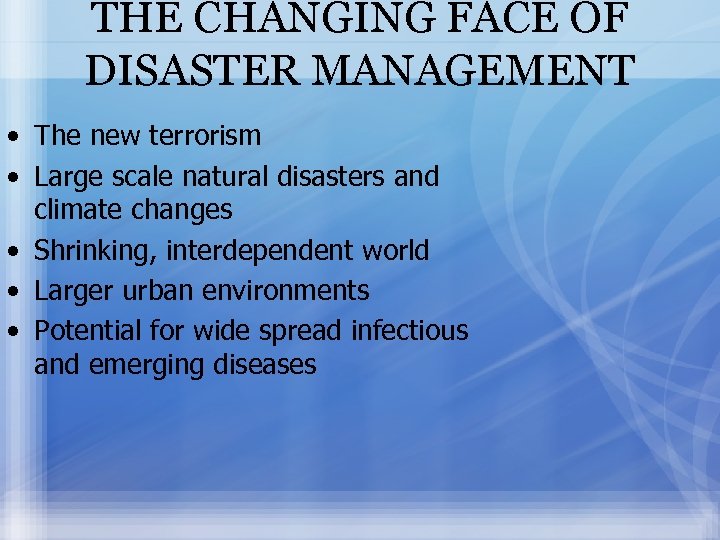
THE CHANGING FACE OF DISASTER MANAGEMENT • The new terrorism • Large scale natural disasters and climate changes • Shrinking, interdependent world • Larger urban environments • Potential for wide spread infectious and emerging diseases

DISASTER ASSUMPTIONS • Resources will be overwhelmed • Medical facilities already at capacity levels • Federal government will not be able to help • Decisions will have to be made at the local level • Established lines of authority may not exist • Despite all our planning, situations will arise that are not anticipated
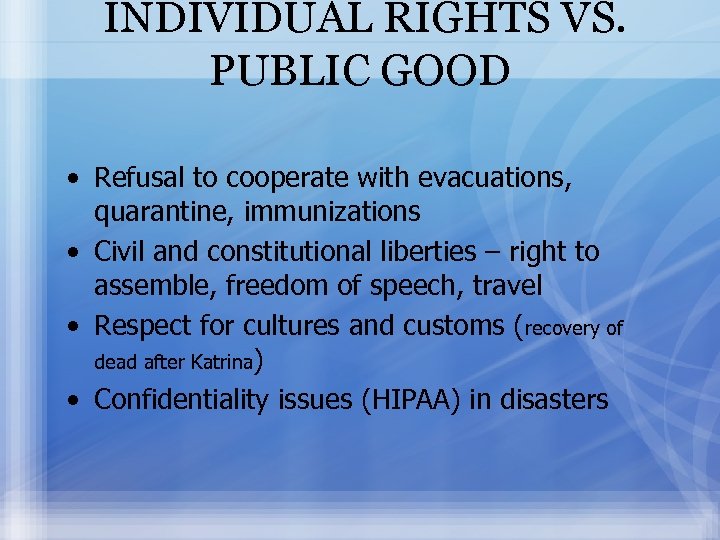
INDIVIDUAL RIGHTS VS. PUBLIC GOOD • Refusal to cooperate with evacuations, quarantine, immunizations • Civil and constitutional liberties – right to assemble, freedom of speech, travel • Respect for cultures and customs (recovery of dead after Katrina) • Confidentiality issues (HIPAA) in disasters

ALLOCATION OF CARE AND TRIAGE DECISIONS • Greatest good for greatest number? • Lives saved vs. years of lives saved • Individual choice (allotting rescue resources to those who refuse to evacuate) • Fairness to all? Prioritizing high value property (wealthy) over less valued (low income). VIP’S?
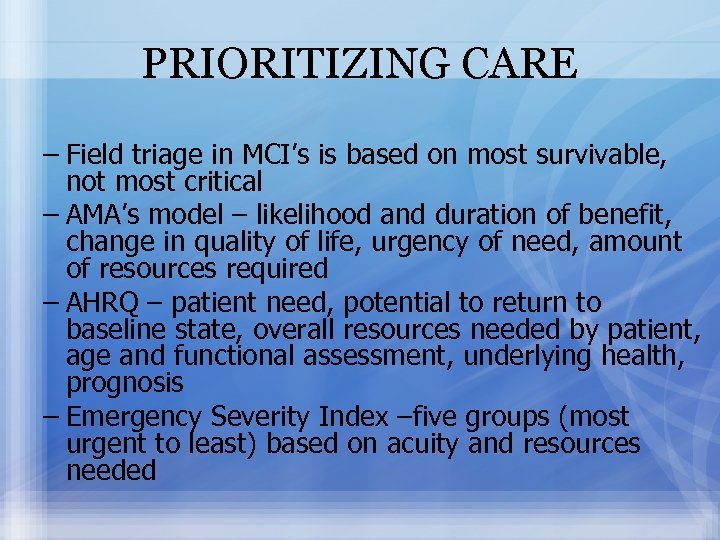
PRIORITIZING CARE – Field triage in MCI’s is based on most survivable, not most critical – AMA’s model – likelihood and duration of benefit, change in quality of life, urgency of need, amount of resources required – AHRQ – patient need, potential to return to baseline state, overall resources needed by patient, age and functional assessment, underlying health, prognosis – Emergency Severity Index –five groups (most urgent to least) based on acuity and resources needed

DUTY TO PROVIDE CARE • Does healthcare provider has a social contract, assumption of risk? • Involuntary immunization • Worker’s Compensation and liability • Labor laws, unions, subcontractors
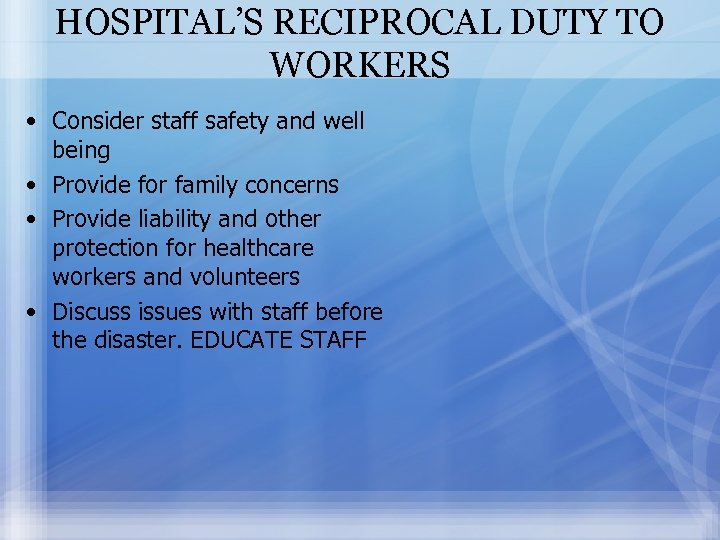
HOSPITAL’S RECIPROCAL DUTY TO WORKERS • Consider staff safety and well being • Provide for family concerns • Provide liability and other protection for healthcare workers and volunteers • Discuss issues with staff before the disaster. EDUCATE STAFF

OTHER COUNTRIES • Family involvement in care • Public relies less on government support • Standard of care differs • Customs, cultural, and religious beliefs • Civil liberties viewed differently – state vs. individual rights
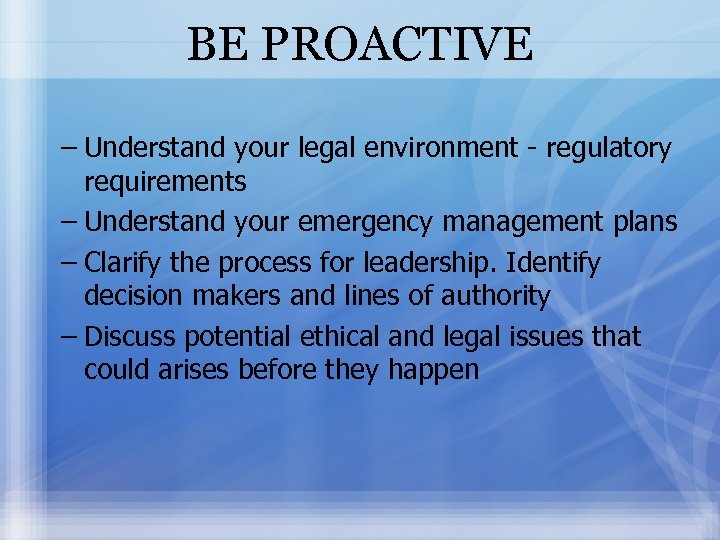
BE PROACTIVE – Understand your legal environment - regulatory requirements – Understand your emergency management plans – Clarify the process for leadership. Identify decision makers and lines of authority – Discuss potential ethical and legal issues that could arises before they happen
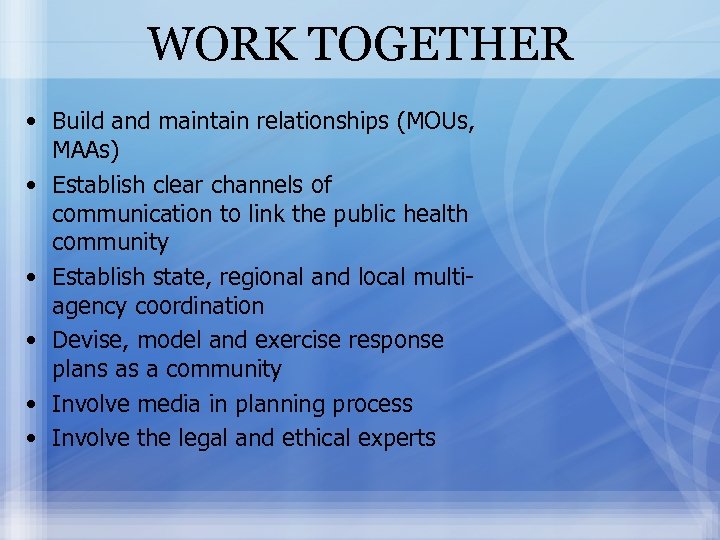
WORK TOGETHER • Build and maintain relationships (MOUs, MAAs) • Establish clear channels of communication to link the public health community • Establish state, regional and local multiagency coordination • Devise, model and exercise response plans as a community • Involve media in planning process • Involve the legal and ethical experts
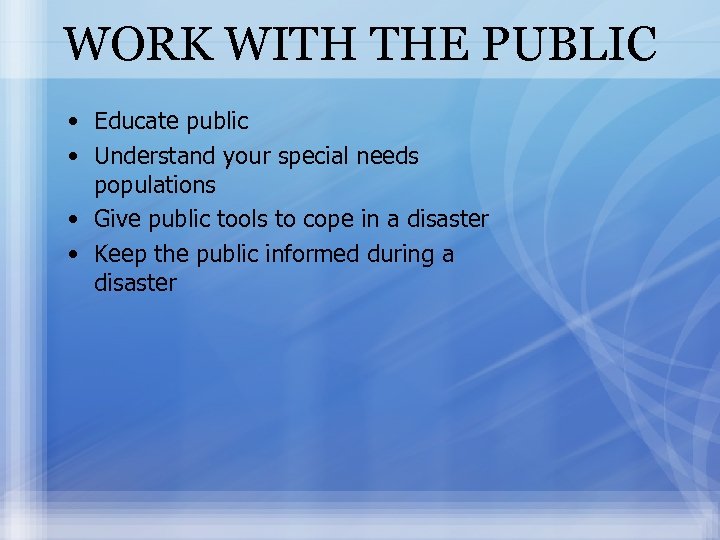
WORK WITH THE PUBLIC • Educate public • Understand your special needs populations • Give public tools to cope in a disaster • Keep the public informed during a disaster
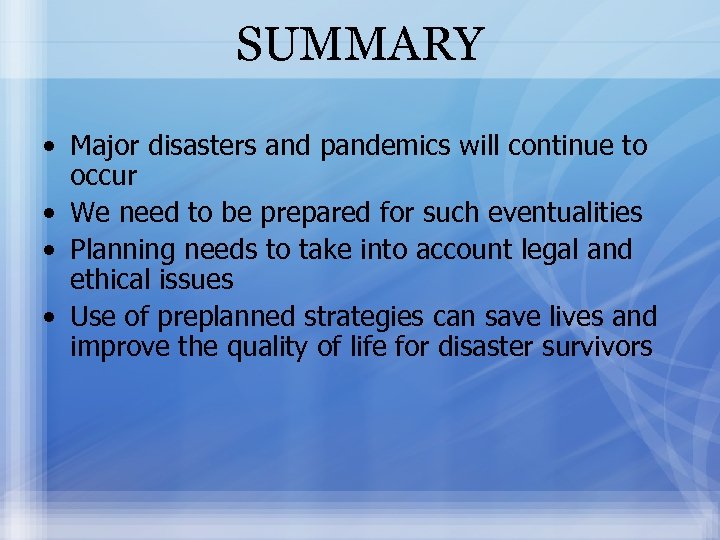
SUMMARY • Major disasters and pandemics will continue to occur • We need to be prepared for such eventualities • Planning needs to take into account legal and ethical issues • Use of preplanned strategies can save lives and improve the quality of life for disaster survivors
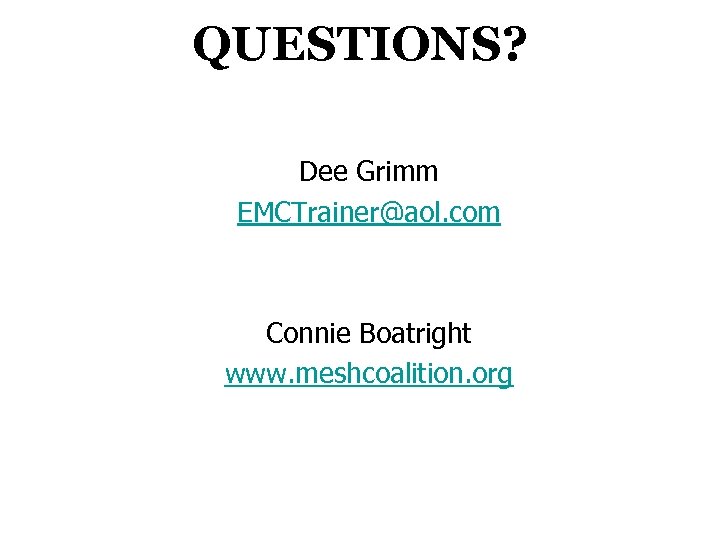
QUESTIONS? Dee Grimm EMCTrainer@aol. com Connie Boatright www. meshcoalition. org
99499bc7dcc5695ef0eeb911274211d6.ppt